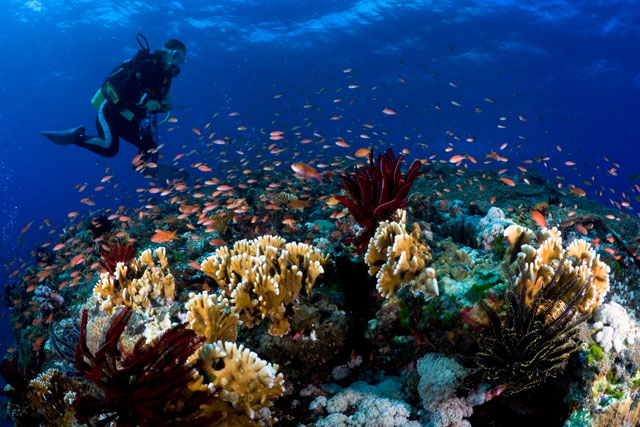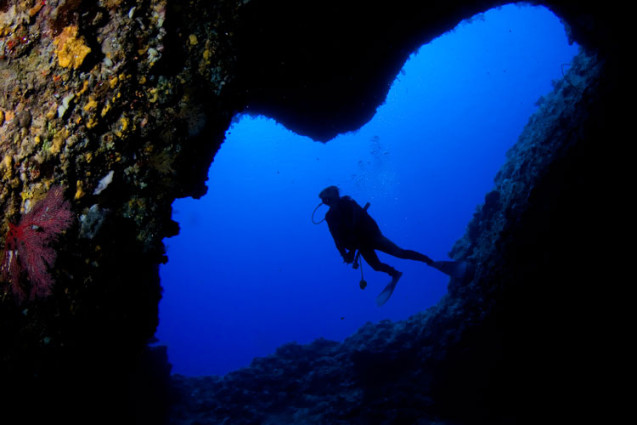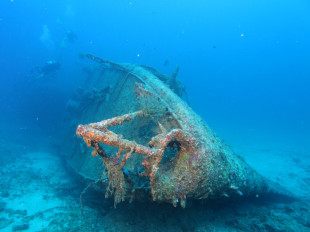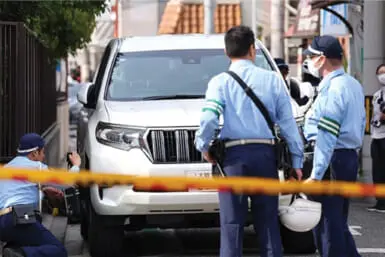You can get a decent view of an island from above as you fly in. You can glance at its sites from the ground as you drive along its highways. But it’s the massive expanse of this great, awesome, ever-moving ocean that truly makes an island. Yes, there’s some good stuff on land too; dancing, singing, eating good food, that kind of frivolity… but islanders live off the sea, and island culture is shaped by the ocean’s humbling presence—the smaller the island, the more ever-present are its briny surroundings. And Okinawa is pretty darn small.
By Andy Gayler
So if you want to know about this barely visible dot on a map, into that ocean you must go. You could just dip your toes in from a pristine sandy beach, but it’s much better to put on a mask, fins, and a tank of air, and get right in there and see what is really going on. In Okinawa, Japan’s sub-tropical gateway, you have one of the best places for diving in East Asia, but it is often overlooked, and many of us hastily head to South East Asia for a scuba diving and cultural experience. This is regrettable, because in Thailand or one of its neighbors, you’re more likely to bump into fellow divers at every coral corner than a turtle, ray or sea snake. Even on Okinawa’s “busy” main island you have a chance to see all of this sea life and much more. And if you haven’t dived before, Okinawa is a great place to get your diving certification—PADI or other. Not only are you assured of Japan’s safety regulations (strict), but outside of the peak season—June to September—you may also end up with your own personal diving tutor taking you through the steps of becoming a part-time fish, while the weather is still superb and the water warm. At night you have nightclubs, great restaurants and izekaya, and live venues where traditional Okinawa music has them dancing between the tables.
Getting started with your diving adventure in Okinawa is straightforward enough. Your hotel will be able to help you, of course, but you may want to plan things for yourself. There are dozens of dive shops across the island—from big, well-staffed centers by the coast, to smaller, more personal outfits operating from people’s homes. But most of these shops are run by Japanese, often mainlanders who moved down for an alternative lifestyle, and English is spoken there at differing levels of proficiency. So if Japanese is not your forte just yet, there are a couple of foreign-run diving outfits you can hook up with (see panel below) who will take you along paths less trodden, to seas less dived as well as to popular tourist sites and, perhaps, give you a unique insight into Okinawa life during your surface chats.
From top to bottom of the main island, between the northern tip’s Cape Hedo and the south’s Itoman, with their strong currents worthy of only the more confident diver, you will find something interesting—caves, dive-through rock formations, reef walls, coral beds and more. And a short boat journey will even take you to much smaller, less-inhabited neighboring islands, such as the Keramas, where the diving is truly special and where underwater visibility up to 40 meters (130 feet) and passing turtles are not unusual.
There are many good dive sites where the diving companies can take you, much depending on the temperament of the sea on the day and what you want to see, but you’re most likely to start at one of two “soft” dive sites, especially if you’re new to the pastime: either Sunabe Sea Wall, near Chatan, where you have what is possibly the centre of Okinawa’s diving industry with its large gathering of dive shops, or the picturesque Cape Maeda, in Onna Village, with its organized car park, showers and snack store. The “Wall” at Sunabe refers to the reinforced coastal promenade that borders this trendy enclave, but it could just as easily refer to the diving itself. Maeda is a gentle reef wall that can be reached by a small swim and is often used for training divers. The site, reached either by boat or down some steep steps, is dominated by towering cliffs and offers another great reef wall with corals and friendly fish, as well as the famous Blue Cave.
And then there are the history dives. Ignoring an occasional gun shell casing, or a now rare, unexploded item, that can be found by the keen eye, there’s one sub-aquatic memento mori in particular that lingers on from the devastating days of the Battle of Okinawa. The USS Emmons fell victim to the infamous Japanese kamikaze attack squads and now lies 45 meters (147 feet) down, just off the coast of tiny Kouri Island, connected by bridge to the north of Okinawa Honto. Be aware, it takes experience to see this decaying battleship and only an advanced diver with more than 50 dives will want to hop on the boat for the short ride to its marker buoy. But it is worth the effort—mostly intact and with its guns still pointing to the surface as though one last shot is about to be fired against a long-ago beaten enemy, it creates an eerie underwater memorial to the highly destructive Pacific War.
But there’s even more to the sea than looking at pretty and sometimes peculiar critters or descending upon a ghostly ship. Just being underwater, breathing slowly, quietly floating like an astronaut in space is an addictive experience all on its own. Once you master the basics of buoyancy control, you can float with the currents, hover in the deep blue and glide around like a manta ray. And then when you calmly resurface from your visit into the deep you will realize island life is not just about the ground we walk on; so much more is happening just below your fins.
DIVE SHOPS
Dive shops that use English as the main language:
Piranha Divers, Onna-son, Okinawa Mostly showing the underwater world to Japan’s expat community and travelers from further away. Web: www.piranha-divers.jp
Reef Encounters, Sunabe, Okinawa Gets a lot of business from the island’s American bases and visiting technical divers. Web: www.reefencounters.org
Places to stay around Okinawa
Located in the heart of Chatan, and minutes away from Sunset Beach, Araha Beach, and Mihama American Village, the Hilton Okinawa Chatan Resort opened in July 2014.
Off the main island, you can sample the charms of Ishigaki Island at the Hotel Nikko Yaeyama.











